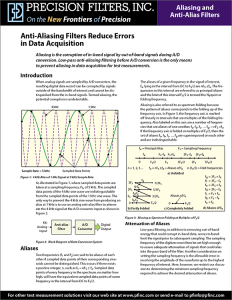The Sampling Theorem states that an analog signal must be sampled at least twice the highest frequency contained in the signal to prevent aliasing. In other words, no information higher than half the sampling frequency can exist in the signal, otherwise aliasing will occur. Signals above Fs/2 do exist in the signal and require a filter to attenuate them to an acceptable level. If you do not properly filter the input signal, the digitized output will contain aliasing errors that look just like real data. Since the signals that alias are unknown, the errors are unknown and cannot be corrected by post-processing.
In Precision Filters new application note “Anti-Aliasing Filters Reduce Errors in Data Acquisition” you will learn how to use a low-pass filter to achieve the required attenuation of aliases while not significantly attenuating the signal itself. Methodology is presented that is applicable to any low-pass filter.
From the laboratory to the test cell, Precision Filters’ programmable anti-aliasing filter/amplifier system line-up has you covered. Choose from the high-density modular 28000 system that packs up to 128 channels of anti-alias filter/amps in a single chassis, the convenient 16-channel PF-1U rack mount filter/amplifier system, or the compact PFA-2 two-channel desktop unit. We even offer a pair of programmable filter modules for NI’s™ popular cDAQ™ and cRIO™ format.
| • | The only zero-ripple elliptic low-pass filters on the market |
| • | 100 dB/octave attenuation slopes and 1° phase match |
| • | Filtering optimized for frequency or time domain measurements with FLAT or PULSE modes |
| • | Choose cutoff frequencies from 1 Hz to over 3 MHz |
| • | Fully integrated and distributed programmable gain amplifiers mean more signal and less noise |
| • | User control via high-level remote commands over Ethernet or with the supplied GUI interface |

